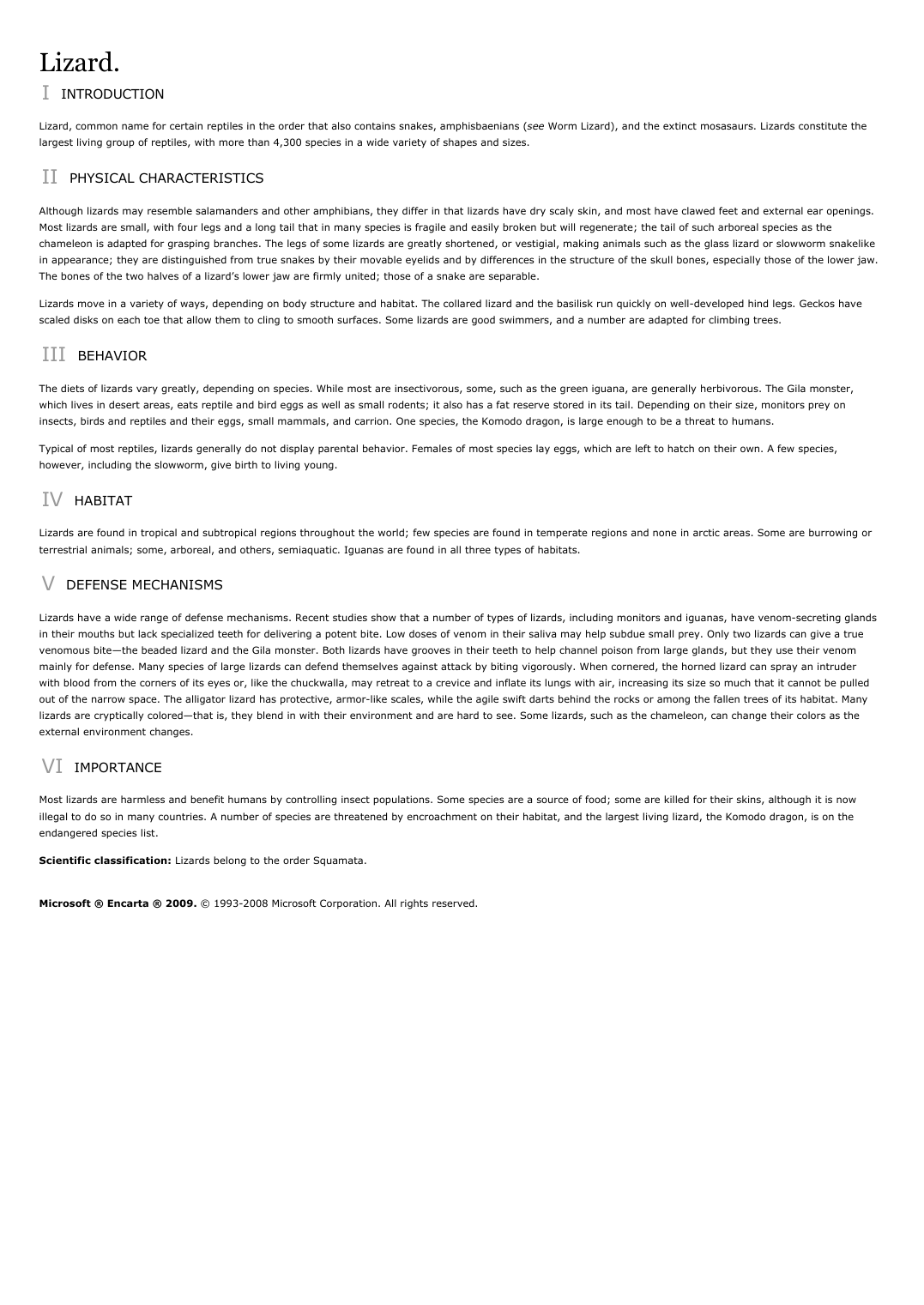Lizard.
Publié le 06/12/2021
Extrait du document
Ci-dessous un extrait traitant le sujet : Lizard.. Ce document contient 684 mots. Pour le télécharger en entier, envoyez-nous un de vos documents grâce à notre système d’échange gratuit de ressources numériques ou achetez-le pour la modique somme d’un euro symbolique. Cette aide totalement rédigée en format pdf sera utile aux lycéens ou étudiants ayant un devoir à réaliser ou une leçon à approfondir en : Echange
Lizard.
I
INTRODUCTION
Lizard, common name for certain reptiles in the order that also contains snakes, amphisbaenians (see Worm Lizard), and the extinct mosasaurs. Lizards constitute the
largest living group of reptiles, with more than 4,300 species in a wide variety of shapes and sizes.
II
PHYSICAL CHARACTERISTICS
Although lizards may resemble salamanders and other amphibians, they differ in that lizards have dry scaly skin, and most have clawed feet and external ear openings.
Most lizards are small, with four legs and a long tail that in many species is fragile and easily broken but will regenerate; the tail of such arboreal species as the
chameleon is adapted for grasping branches. The legs of some lizards are greatly shortened, or vestigial, making animals such as the glass lizard or slowworm snakelike
in appearance; they are distinguished from true snakes by their movable eyelids and by differences in the structure of the skull bones, especially those of the lower jaw.
The bones of the two halves of a lizard's lower jaw are firmly united; those of a snake are separable.
Lizards move in a variety of ways, depending on body structure and habitat. The collared lizard and the basilisk run quickly on well-developed hind legs. Geckos have
scaled disks on each toe that allow them to cling to smooth surfaces. Some lizards are good swimmers, and a number are adapted for climbing trees.
III
BEHAVIOR
The diets of lizards vary greatly, depending on species. While most are insectivorous, some, such as the green iguana, are generally herbivorous. The Gila monster,
which lives in desert areas, eats reptile and bird eggs as well as small rodents; it also has a fat reserve stored in its tail. Depending on their size, monitors prey on
insects, birds and reptiles and their eggs, small mammals, and carrion. One species, the Komodo dragon, is large enough to be a threat to humans.
Typical of most reptiles, lizards generally do not display parental behavior. Females of most species lay eggs, which are left to hatch on their own. A few species,
however, including the slowworm, give birth to living young.
IV
HABITAT
Lizards are found in tropical and subtropical regions throughout the world; few species are found in temperate regions and none in arctic areas. Some are burrowing or
terrestrial animals; some, arboreal, and others, semiaquatic. Iguanas are found in all three types of habitats.
V
DEFENSE MECHANISMS
Lizards have a wide range of defense mechanisms. Recent studies show that a number of types of lizards, including monitors and iguanas, have venom-secreting glands
in their mouths but lack specialized teeth for delivering a potent bite. Low doses of venom in their saliva may help subdue small prey. Only two lizards can give a true
venomous bite--the beaded lizard and the Gila monster. Both lizards have grooves in their teeth to help channel poison from large glands, but they use their venom
mainly for defense. Many species of large lizards can defend themselves against attack by biting vigorously. When cornered, the horned lizard can spray an intruder
with blood from the corners of its eyes or, like the chuckwalla, may retreat to a crevice and inflate its lungs with air, increasing its size so much that it cannot be pulled
out of the narrow space. The alligator lizard has protective, armor-like scales, while the agile swift darts behind the rocks or among the fallen trees of its habitat. Many
lizards are cryptically colored--that is, they blend in with their environment and are hard to see. Some lizards, such as the chameleon, can change their colors as the
external environment changes.
VI
IMPORTANCE
Most lizards are harmless and benefit humans by controlling insect populations. Some species are a source of food; some are killed for their skins, although it is now
illegal to do so in many countries. A number of species are threatened by encroachment on their habitat, and the largest living lizard, the Komodo dragon, is on the
endangered species list.
Scientific classification: Lizards belong to the order Squamata.
Microsoft ® Encarta ® 2009. © 1993-2008 Microsoft Corporation. All rights reserved.
Lizard.
I
INTRODUCTION
Lizard, common name for certain reptiles in the order that also contains snakes, amphisbaenians (see Worm Lizard), and the extinct mosasaurs. Lizards constitute the
largest living group of reptiles, with more than 4,300 species in a wide variety of shapes and sizes.
II
PHYSICAL CHARACTERISTICS
Although lizards may resemble salamanders and other amphibians, they differ in that lizards have dry scaly skin, and most have clawed feet and external ear openings.
Most lizards are small, with four legs and a long tail that in many species is fragile and easily broken but will regenerate; the tail of such arboreal species as the
chameleon is adapted for grasping branches. The legs of some lizards are greatly shortened, or vestigial, making animals such as the glass lizard or slowworm snakelike
in appearance; they are distinguished from true snakes by their movable eyelids and by differences in the structure of the skull bones, especially those of the lower jaw.
The bones of the two halves of a lizard's lower jaw are firmly united; those of a snake are separable.
Lizards move in a variety of ways, depending on body structure and habitat. The collared lizard and the basilisk run quickly on well-developed hind legs. Geckos have
scaled disks on each toe that allow them to cling to smooth surfaces. Some lizards are good swimmers, and a number are adapted for climbing trees.
III
BEHAVIOR
The diets of lizards vary greatly, depending on species. While most are insectivorous, some, such as the green iguana, are generally herbivorous. The Gila monster,
which lives in desert areas, eats reptile and bird eggs as well as small rodents; it also has a fat reserve stored in its tail. Depending on their size, monitors prey on
insects, birds and reptiles and their eggs, small mammals, and carrion. One species, the Komodo dragon, is large enough to be a threat to humans.
Typical of most reptiles, lizards generally do not display parental behavior. Females of most species lay eggs, which are left to hatch on their own. A few species,
however, including the slowworm, give birth to living young.
IV
HABITAT
Lizards are found in tropical and subtropical regions throughout the world; few species are found in temperate regions and none in arctic areas. Some are burrowing or
terrestrial animals; some, arboreal, and others, semiaquatic. Iguanas are found in all three types of habitats.
V
DEFENSE MECHANISMS
Lizards have a wide range of defense mechanisms. Recent studies show that a number of types of lizards, including monitors and iguanas, have venom-secreting glands
in their mouths but lack specialized teeth for delivering a potent bite. Low doses of venom in their saliva may help subdue small prey. Only two lizards can give a true
venomous bite--the beaded lizard and the Gila monster. Both lizards have grooves in their teeth to help channel poison from large glands, but they use their venom
mainly for defense. Many species of large lizards can defend themselves against attack by biting vigorously. When cornered, the horned lizard can spray an intruder
with blood from the corners of its eyes or, like the chuckwalla, may retreat to a crevice and inflate its lungs with air, increasing its size so much that it cannot be pulled
out of the narrow space. The alligator lizard has protective, armor-like scales, while the agile swift darts behind the rocks or among the fallen trees of its habitat. Many
lizards are cryptically colored--that is, they blend in with their environment and are hard to see. Some lizards, such as the chameleon, can change their colors as the
external environment changes.
VI
IMPORTANCE
Most lizards are harmless and benefit humans by controlling insect populations. Some species are a source of food; some are killed for their skins, although it is now
illegal to do so in many countries. A number of species are threatened by encroachment on their habitat, and the largest living lizard, the Komodo dragon, is on the
endangered species list.
Scientific classification: Lizards belong to the order Squamata.
Microsoft ® Encarta ® 2009. © 1993-2008 Microsoft Corporation. All rights reserved.
↓↓↓ APERÇU DU DOCUMENT ↓↓↓

































